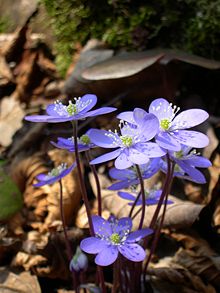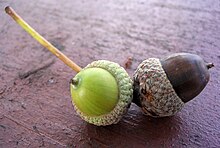Seed spread
The seed dispersal in plants is the process of passive transport of diaspore ( seeds ) for the purpose of propagation of the plants.
It is important to distinguish the process of spreading - the dynamics of vegetation - from the result of the process, the spreading of species - as examined by geobotany .
Plants use a number of different mechanisms to spread their seeds. These are generally divided into six broad groups:
- the zoochory , the spread through animals
- the anemochory , the spread by wind
- the semachory , the spread through wind and animal scattering
- the hydrochory , the spread through water
- the hemerochory , the human spread
- the autochory , the self-expansion.
When two different seed pods appear on a plant, one speaks of heterocarpy .
A further distinction is now made:
Allochory
Seed spread by forces (agents) that lie outside the mother plant (e.g. wind, water, animals).
Zoochory
The zoochory , the spread through animals, knows the following fine division:
- Epichory , the spread by attachment
- Endochoria , the so-called digestive spread
- Myrmecochory , the spread of ants
- Ornithochory , the spread of birds
-
Dysochoria , the random spread
- Synzoochory , the spread of hiding
- Edit spread
- Spread during nest building
Some authors also include the animal ballists and the anthropochory in the zoochory.
When animals spread, mammals and birds , but also insects, are the spreaders. A special form of zoochory is anthropochory - the spread through humans.
They either ingest the seed with the food and excrete it later ( endochory ) or deposit it in a hiding place as part of the food provision ( squirrels that hide nuts and many of them cannot be found again, see hiding place spread ) or the seeds have special ones Adhesion mechanisms with which they adhere to the fur or feathers of animals (e.g. burdock or sticky substances such as oak mistletoe , see epichory ).
If the semen spreads via the mechanism of food intake, the semen must be protected from destruction during food chewing (chewing) and the breakdown of the food in the digestive tract by a solid, resistant cover or other structure. How effective this spreading mechanism can be is shown by the “tomato forests” that can grow up in the fields after fertilization with sewage sludge.
Anemochory
Anemochory , the spread of wind is the most original form of plant spread. It was used by the first land plants on earth. This form is further divided into the
- Meteorochory , spread by aviators
- Chamaechorie , the spread by trolleys
- Boleochor ( wind spreader )
In anemochory, the plant uses air movement to spread its seeds. This can be done by the fact that the plant is "shaken" in stronger winds and releases its seeds in the process, or that the seeds sometimes have complicated flight mechanisms which they can carry away from the mother plant over long distances.
Probably the best known are the small " parachutes " - they are formed from the calyx ( pappus ) during seed ripening - in dandelions and similar daisy family .
The fruits of the various maple species ( Aceraceae ) are also well known for their striking propeller-like flight in autumn. The seeds of ash ( Fraxinus ) and elm ( Ulmus ) are similar ; they are winged, single-seeded nut fruits, which are called "Samara".
Semachory

The semachory is subdivided more finely into animal scattering (ball pizoochory) and wind scattering . The difference to the anemochory is that the diaspores cannot fly. Movements of the plant caused by wind or animal movements only ensure that capsules, pods, follicles are unbalanced in such a way that they distribute the seeds similar to a scatter box.
Hydrochory
When the water spreads , the seeds often have floating devices in the form of air sacs. But there are also species that mainly release their seeds when it rains (e.g. rocking movements when raindrops hit) and hope that the seeds will be washed away.
An impressive example of the spread of water is the seed of the coconut palm . The outer pericarp of the coconut is fibrous and air-filled when it spreads, so that the whole seed is buoyant. Despite its name as a nut, the coconut is not a nut in the botanical sense, but a stone fruit .
The hydrochory is more finely divided into
- Nautochory , the swimming spread
- Bythisochory , the spread by the flow of flowing waters
- Ombrochory , the spread by raindrops with the fine division into
Hemerochory
The hemerochory (people migrating ) is one of the most important forms of spreading with which plants conquer completely new habitats. This includes the
- Ethelochory , the spread through seeds (intentional)
- Speirochorie , the spread as a seed companion (unintentional)
- Agochory , the spread by unintentional transport (unintentional)
Autochory
The mechanisms that are available to plants for self- propagation are summarized under autochory .
- Ballochorie , the spread by centrifugal mechanisms, which in turn is more finely divided into
- Herpechoria , the spread by the diaspores' own movement
- Barochory , the spread by gravity
- Blastochory , the spread by self-offshoots
The self-propagation mechanisms range from the spherical shape (Kullereffekt) to complicated shapes such as skidding (z. B. geraniaceae ) or creep (z. B. filaree plants ) of the seeds. Mechanisms that rely solely on gravity (cf. Kullere effect) are called barochore mechanisms. The seeds are usually heavy and rounded. With these devices, some species span several meters.
Propagation behavior
A further distinction is made between the spread behavior:
- Commute; Diaspores without structures for long-distance spread
- Local propagation ( topochory , engychory, anti-telechory, proxychory); Diaspores without structures for long-distance spread
- Remote propagation ( telechory ); Diaspores with structures for long-distance spreading
- Non-propagation (achory, atelechory); Diaspores with mechanisms to prevent them from spreading, often barochoric.
- real viviparity
- Amphicarpy; , with above-ground (aerocarp) and underground (geocarp) diaspores
- Basic carpie; with diaspores at the base of a plant
- Synaptospermia; several seeds grouped in a diaspore
- Trypanocarpy; with diaspores that anchor themselves in the ground
In myxospermia, the seed coat surfaces are naturally slimy, this serves to glue the diaspores to the substrate, so it inhibits spread.
There are also the names Eurychorie (wide geographical distribution) and Stenochory (limited distribution area).
If only one mode of expansion occurs, this is called mono- or haplochorie . If two or more modes of propagation occur at the same time , one speaks of di- and polychory . In diplochorie (double propagation), two modes of propagation occur one after the other .
literature
- Wolfgang Frey , Rainer Lösch : Geobotany. 3rd edition, Springer 2010, 2014, ISBN 978-3-662-45280-6 , pp. 333-340.
- B. Schmid, J. Stöcklin: Population biology of plants. Springer, 1991, ISBN 978-3-0348-5638-6 , p. 42 ff.





